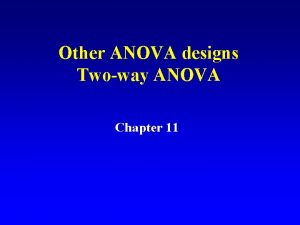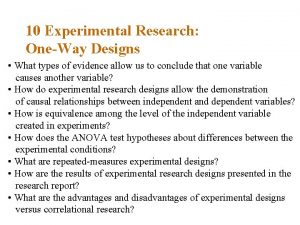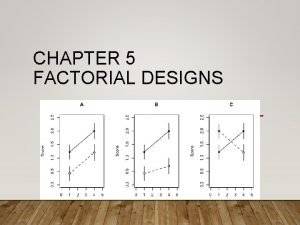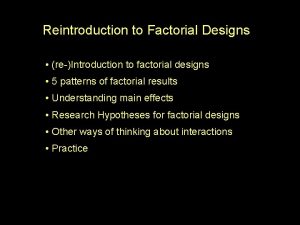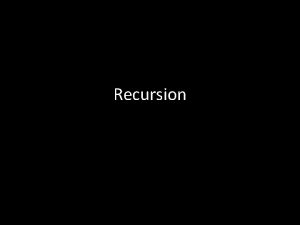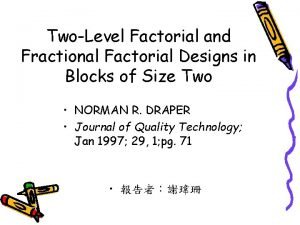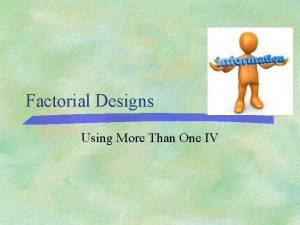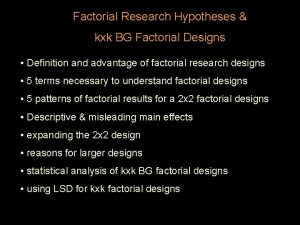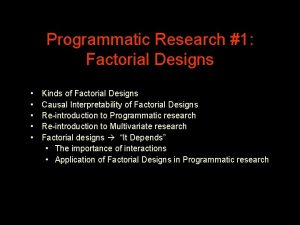3 way Factorial Designs Expanding factorial designs Effects














- Slides: 14

3 -way Factorial Designs • Expanding factorial designs • Effects in a 3 -way design • Causal Interpretations of 3 -way factorial effects • Defining a 3 -way interaction • Describing and “checking” a 2 -way interaction • Describing and “checking” a main effect • Summary of “Descriptive” & “Misleading” effects • Causal Interpretations of 3 -way factorial effects

3 -way Factorial Designs The simplest factorial design is a 2 x 2, which can be expanded in two ways: 1) Adding conditions to one, the other, or both IVs

2) Add a 3 rd IV (making a 3 -way factorial design) Learning Psyc Methods Ugrads Grads Learning Psyc Content Ugrads Grads Computer Instruction Lecture Instruction Identify the three IVs in this design. . . Specify the properties of each condition/cell of this design. . .

3 -Way Factorial Effects There are 7 effects involved in a 3 -way factorial • 3 main effects (one for each IV) • 3 2 -way interactions (one for each pair of IVs) • 1 3 -way interaction For the example name the. . . • main effects 1. Topic 2. Instruction Method 3. Ed. level • 2 -way interactions 1. Topic X Inst. Method 2. Topic X Ed. Level 3. Inst. Method X Ed. Level • 3 -way interaction Topic X Instruction Method X Ed. level

What does a 3 -way interaction look like? • Remember that a 2 -way interaction is, “when the effect of one IV is different for different levels of a 2 nd IV” • Extending this to a design with 3 IVs, a 3 -way interaction is, “when the interaction of two IVs is different for different levels of a 3 rd IV” Familiar Task Practice Difficulty 1 10 Easy 90 90 Hard 50 70 SE of Practice is different for Easy and Hard Tasks (all Familiar tasks) Unfamiliar Task Practice Difficulty 1 10 Easy 90 90 Easy 70 80 Hard 50 70 Hard 10 60 The 2 -way interaction of Practice and Difficulty is different for Familiar and Unfamiliar Tasks

3 -Way Factorial Effects Familiar Task Unfamiliar Task Practice Difficulty 1 10 Easy 90 90 Easy 60 80 Hard 50 70 Hard 10 60 3 -way Interaction The three-way interaction is described based on cell means In order to describe the 3 -way interaction you must pick: 1. The “primary simple effect” which IV you care about most 2. The “primary moderating variable” which IV you want to know if it “conditionalizes” the primary SE 3. The “secondary moderating variable” which IV you want to know if it “further conditionalizes” the primary SE

3 -Way Factorial Effects Familiar Task Unfamiliar Task Practice Difficulty 1 10 Easy 90 90 Easy 70 80 Hard 50 70 Hard 10 60 3 -way Interaction The three-way interaction is described based on cell means Using Practice, Difficulty and Familiarity, respectively… We want to describe how the Practice SE is different for Easy & Hard tasks, and how that pattern is different for Familiar v Unfamiliar tasks Familiar Tasks Difficulty 1 10 Easy = Hard << Unfamiliar Tasks Difficulty 1 10 Easy < Hard <<<<<

3 -Way Factorial Effects Familiar Task Unfamiliar Task Practice Difficulty 1 10 Easy 90 90 Easy 60 80 Hard 50 70 Hard 10 60 2 -way Interaction A two-way interaction is described based on semi-marginal means For a particular 2 -way, the semi-marginal means are the mean for each combination of the IVs for that 2 -way, averaging across conditions of the 3 rd IV. If the 3 -way is significant, then you have to check whether the pattern of the 2 -way is descriptive or misleading, but comparing the simple effect of that 2 -way for each value of the 3 rd IV.

3 -Way Factorial Effects Familiar Task Unfamiliar Task Practice Difficulty 1 10 Easy 90 90 Easy 60 80 Hard 50 70 Hard 10 60 Semi-marginal means for the Practice x Difficulty 2 -way Practice Difficulty 1 10 Easy 75 < 85 Hard 30 <<<< 65 Checking if that 2 -way is descriptive… Familiar Tasks Difficulty 1 10 Easy = Hard << Unfamiliar Tasks Difficulty 1 10 Easy < Hard <<<<< Nope !! The simple 2 -way patterns are different!

3 -Way Factorial Effects Familiar Task Unfamiliar Task Practice Difficulty 1 10 Easy 90 90 Easy 60 80 Hard 50 70 Hard 10 60 Main Effect A main effect is described based on marginal means For a particular main effect, the marginal means are the mean for each combination of that IV, averaging across conditions of the other two IVs. If the 3 -way is significant, then you have to check whether the pattern of the main effect is descriptive or misleading, but comparing the main effect pattern to the pattern of each simple effect of that IV for each combination of the other two IVs

3 -Way Factorial Effects Familiar Task Unfamiliar Task Practice Difficulty 1 10 Easy 90 90 Easy 60 80 Hard 50 70 Hard 10 60 Marginal means for the Practice main effect Practice 1 10 52. 5 << 75 Checking if that Main effect is descriptive… Familiar Tasks Difficulty 1 10 Easy = Hard << Unfamiliar Tasks Difficulty 1 10 Easy < Hard <<<<< Nopet!! There is no Practice effect for Easy Familiar tasks!

Descriptive and Misleading Effects in 3 -way Designs What about the 3 -way interaction? The 3 -way interaction - significant or not - is always descriptive ! What about the 2 -way interactions? If the 3 -way is non-significant, all three 2 -ways are descriptive If the 3 -way is significant, all 2 -way & main effects are “suspect” If the 3 -way is significant, a 2 -way is only descriptive if that 2 -way has the same pattern for each condition of the 3 rd IV

What about the main effects ? The main effect of an IV that is not involved in any 2 -way or 3 -way interaction is always descriptive If the 3 -way is significant, a main effect is only descriptive if that main effect has the same pattern for each combination of the other two IVs If a 2 -way is significant, the main effects of those IVs are “suspect” If a 2 -way is significant, the main effect of an IV involved in that interaction is only descriptive if that main effect has the same pattern for each condition of the other IV

Causal Interpretations of 3 -way Designs • When can a main effect be causally interpreted ? When the conditions of the IV is RA, Manip, & there are no confounds. . • When can a 2 -way interaction be causally interpreted ? When the conditions of both the involved IVs are RA, Manip, & there are no confounds. . • When can a 3 -way interaction be causally interpreted ? When the conditions of all three of the involved IVs are RA, Manip, & there are no confounds. .
 Within-subject design example
Within-subject design example Three way factorial design
Three way factorial design Randomized block design example
Randomized block design example One-way experimental design
One-way experimental design Pertanyaan tentang anova
Pertanyaan tentang anova Perbedaan one way anova dan two way anova
Perbedaan one way anova dan two way anova The old way and the new way
The old way and the new way Relative frequency two way table
Relative frequency two way table What does one way anova tell you
What does one way anova tell you One was a ship
One was a ship Two way anova
Two way anova One way anova vs two way anova
One way anova vs two way anova Talk this way
Talk this way Definition of threaded binary tree
Definition of threaded binary tree Expanding dynamometer
Expanding dynamometer


